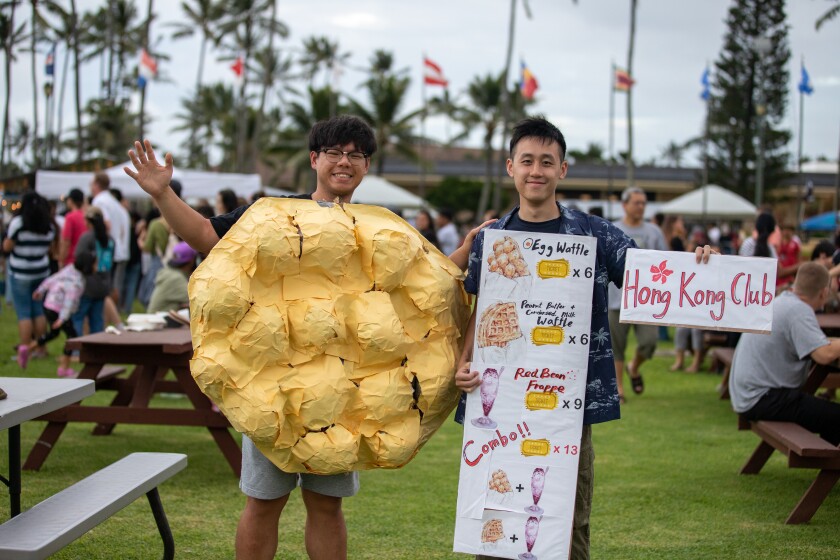BYUH ohana and local community members gather to taste the cuisine prepared by 38 diverse student clubs

Thirty-eight clubs displayed unique, cultural dishes of food at their stalls as aromas of spices and sauces filled the air during BYU–Hawaii’s Food Fest 2022.
Crowds of people rushed between the different clubs’ stalls in the Flag Circle on Saturday, Nov. 11, enjoying the event. Thirteen of the clubs were from Asia, including Cambodia, Indonesia, Mongolia and the Philippines.
First-time participant Saran Kumar Sekar, a freshman from India studying hotel and tourism management, said this is a new experience for him. “[The colleges in India] don’t have different clubs from various nationalities as we have here at BYUH. It’s great to see everyone coming together.”
Former Cambodia Club President and current Vice President of Activities, Soktheavy Phouk, a junior studying political science from Cambodia, said there was a sentimental value behind the food her club chose to make this year. Phouk explained, “Nom plae ai is a small mochi ball with brown sugar and fresh coconut filling. When you bite it, you can feel it burst in your mouth. That was my favorite dessert as a kid. Now I want the world to experience the joy I had with this dessert.” Cambodia Club members sold three desserts at Food Fest: jek k’teis, nom korm and nom plae ai.
Shiori Shimada, a senior from Japan majoring in elementary education, said she loved the nom plae ai dessert. “We have mochi dessert in Japan, but this was new to me. It was so good. I didn’t expect a mochi ball to have coconut [as a filling]. That was a perfect combination.”
Shimada shared her experience was different from last year because this year she got to walk around instead of helping her club. She said, “My friends and I bought [food] from most of the stalls and tried them all together. [I’m] so happy I get to experience cultural diversity in Hawaii.”

To make Food Fest a unique experience this year, Jay-r Ragsag, a freshman studying business management and the current president of the Filipino Club, said the club presidency and committee decided together to make popular Filipino street food. He said they chose kwek kwek, which are deep-fried boiled quailed eggs covered with orange batter, and Filipino barbecue. When asked about his childhood memories of Filipino street food, Ragsag explained the barbecue reminded him of his first family business.
He said, “I remember barbecuing with my family and selling skewers at the night market when I was a kid.” Ragsag said it was a wonderful experience but also sad because they sold out pretty quickly. “It was hard to tell people that we were sold out when the line was still long.” This experience has taught him to always make extra food for Food Fest, he said.
Thinking back on his childhood, former Korea Club Vice President Sijun Lim, a junior studying computer science from South Korea, shared a tender memory of his mother. “When I was a little kid, my mom always took me to a tteokbokki place. She bought one or two bucks of cheap tteokbokki for me, and that’s the best tteokbokki I’ve ever had. That’s like tteokbokki is part of Korean pride and identity, Lim explained. “Although almost every Korean student knows how to make tteokbokki. The recipe can be unique from family to family,” he said. Tteokbokki are spicy rice cakes.
Sumiya Munkhbaatar, a sophomore studying finance and the former vice president for the Mongolia Club, explained the reason behind her club’s chosen menu. She said the Mongolian Club served chicken rolls with fried potatoes and a fresh salad to reflect the diversity of BYUH. “Chicken isn’t the main meat that we eat in Mongolia, but [we made it] because we’re in Hawaii and Food Fest is kind of like a [celebration of diversity].” She explained they usually only use chicken during celebrations, but the Mongolia Club thought it would be good to make a fusion dish. Munkhbaatar expressed her hope to make more fusion dishes with other cultures for the next Food Fest.
